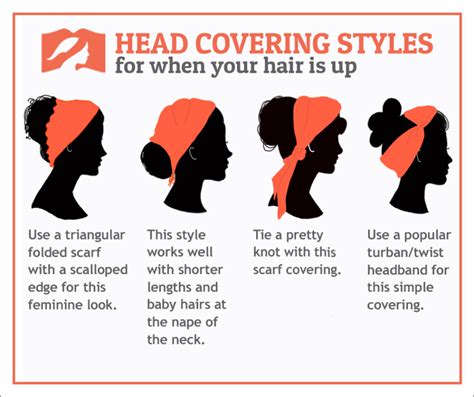Introduction
Head coverings have adorned women across cultures and time periods, symbolizing religious, cultural, and personal expression. From the elaborate veils of ancient civilizations to the modern headbands and hijabs, head coverings continue to empower women by providing a means of self-expression and protection. In this comprehensive guide, we delve into the diverse world of head coverings for women, exploring their origins, styles, and benefits.

A History of Head Coverings
Ancient Origins:
Head coverings can be traced back to ancient Mesopotamia and Egypt, where women wore headpieces made of linen, wool, or leather to protect their heads from the sun and sand. These coverings also denoted social status and religious affiliation.
Religious Significance:
Many religions have adopted head coverings as a symbol of modesty, obedience, and reverence. In Christianity, women may wear headscarves during worship services as a sign of submission to God. In Islam, the hijab is considered mandatory for Muslim women to maintain privacy and modesty.
Cultural Identity:
Head coverings have also become an integral part of cultural identity around the world. In some African cultures, headscarves or wraps are worn as a way to signify tribal affiliation or marital status. In India, the sari, a versatile drape, includes a head covering that enhances the outfit’s elegance.
Types of Head Coverings
The sheer variety of head coverings reflects the diverse cultures and traditions of women around the globe. Here are some of the most common types:
- Veils: Full-coverage coverings that conceal the face and hair, such as the niqab and burqa.
- Headscarves: Square or rectangular pieces of fabric tied around the head in various styles, including the kerchief, babushka, and bandana.
- Wraps: Stretchy or loose fabrics that can be wrapped around the head, such as the turban and headscarf.
- Hats: Head coverings with a structured crown and brim, such as the beanie, sun hat, and straw hat.
- Bonnets: Close-fitting head coverings with a brim around the face, such as the bonnet and pillbox hat.
Benefits of Head Coverings
Beyond their cultural and religious significance, head coverings offer numerous practical and aesthetic benefits:
Protection:
Head coverings protect the hair and scalp from sun damage, cold weather, and pollution.
Modesty and Privacy:
For many women, head coverings provide a sense of modesty and privacy by concealing their hair and revealing less of their bodies.
Style and Fashion:
Head coverings add a touch of elegance and style to any outfit. They can complement different hairstyles and face shapes, creating a unique and eye-catching look.
Hair Management:
Head coverings can help tame unruly hair, prevent tangles, and reduce the need for frequent washing.
Choosing the Right Head Covering
When choosing a head covering, consider the following factors:
- Purpose: Determine why you’re wearing a head covering (religious reasons, protection, fashion).
- Comfort: Ensure the fabric is breathable and fits comfortably on your head.
- Style: Choose a design that complements your personal style and facial features.
- Occasion: Select a head covering appropriate for the occasion, whether it’s formal or casual.
Tips and Tricks
- Experiment with styles: Try different ways of tying or wrapping head coverings to create unique looks.
- Accessorize: Add embellishments such as beads, scarves, or jewelry to personalize your head covering.
- Care for your head covering: Wash and store your head coverings properly to maintain their appearance and longevity.
- Embrace your confidence: Wear your head covering with pride and confidence. It’s an expression of your identity and individuality.
Inspiring Head Covering Designs
- Adorned Veils: Intricate veils featuring lace, embroidery, or beadwork, such as the mantilla.
- Artistic Headwraps: Wraps adorned with vibrant prints, patterns, or cultural motifs, such as the gele.
- Fashionable Hats: Wide-brimmed hats in bold colors or unconventional materials, such as the cloche hat.
- Modern Bonnets: Bonnets with updated silhouettes, such as the bucket hat or slouchy beanie.
Empowering Women Through Head Coverings
Head coverings have played a significant role in empowering women for centuries. They provide a means for women to express their individuality, assert their cultural heritage, and challenge societal norms.
Creating a Sense of Belonging:
For women who wear head coverings for religious or cultural reasons, these coverings can provide a sense of belonging to a community that shares their values.
Challenging Stereotypes:
By embracing their head coverings, women challenge stereotypes and demonstrate that their religious beliefs or cultural heritage do not define their abilities or worth.
Inspiring Confidence:
Wearing a head covering can boost women’s confidence by empowering them to express their identity in a way that is meaningful to them.
Head Covering Statistics
- According to a 2021 survey by the Pew Research Center, 63% of Muslim women in the United States wear a headscarf or hijab.
- A 2020 study by the University of California, Berkeley found that women who wear head coverings are more likely to experience higher levels of self-esteem and satisfaction with their appearance.
- In 2019, the global market for head coverings was valued at approximately $45 billion and is projected to grow to $67 billion by 2027.
Innovative Head Coverings
Emerging technologies and creative innovations are pushing the boundaries of head coverings:
- Smart Headscarves: Headscarves integrated with sensors that monitor brain activity and provide real-time health data.
- UV-Protective Wraps: Stretchy wraps with built-in UV protection to safeguard the scalp and hair from sun damage.
- Customizable Hats: Hats that can be personalized with interchangeable brims, colors, and patterns to match any outfit or mood.
Conclusion
Head coverings for women are a testament to the diversity, creativity, and empowerment of the female spirit. From ancient veils to modern headbands, these coverings have evolved in styles and purposes but remain a vital expression of personal identity, cultural heritage, and religious beliefs. By embracing the power of head coverings, women can enhance their confidence, challenge societal norms, and continue to inspire generations to come.
